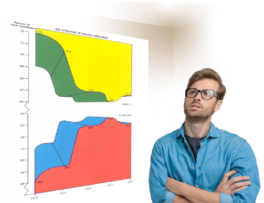Dec 7 2022
Effective Visualizations
During the Van-of-Nerds Tour de France, in 9/22, one of our hosts said, “It’s one thing to collect data, but it’s another to make simple and usable summaries for people.” Some of the visualizations we saw at several sites, however, showed that our hosts underestimate what it takes to generate “simple and usable summaries.”
Contents
Example: A Line Plot
One host showed us a chart with point markers so large that they hid the variable’s evolution over time. It looked like this:

You can see better with smaller points:

And you can see even better by changing the scale of the y-axis:

Incidentally, the KPI plotted in this example is France’s unemployment rate in %, as compiled by the World Bank. Whether is 12.5% as in 1997, or 7.5% as in 2021 makes a difference in the lives of millions.
Other examples
Here are a few other examples we saw during our tour:
- Inconsistent color codes. On two charts displayed side-by-side, red was used with different meanings. For ease of understanding, color codes should be consistent.
- Line plots overlaid on vertical bar charts. are confusing, because these types of charts are applicable in different contexts. Line plots are for quantities where interpolation makes sense, like temperatures measured at fixed intervals, or quantities measured at a higher frequency than you can show on the x-axis, like daily production volumes with x-axis labels by month.
- Lack of annotations. Annotations are essential in using charts, and, when charts displayed on a production floor are pristine, it is a tell-tale sign that no one uses them. Annotations, however, must be large and bold enough for viewers to read from where they stand. With liveboards, it is possible to allow viewers to annotate charts on a screen with pen-like devices and retain the annotations.
Vertical bar charts are for quantities like monthly volumes, where interpolation does not make sense. If you have both kinds, you make a separate chart for each, stacking them vertically to tie them to a common time axis.
Visualizations for Communication, not Decoration
As a general rule, visualizations are for communication, not decoration, the exception being visualizations you produce to comply with external mandates and that auditors must see in the mandated formats. As much as possible, you should keep them separate from the ones that actually help in operations. This is in line with the distinction explicitly made in Japan between the facade you show outsiders, or tatemae, and the way you actually work, the “true sound,” or honne.
You need relevant visualizations for each audience, be they managers, engineers, technicians, or operators, at its workplace, and these visualizations must not require multiple clicks to access. As outsiders are not adept at guessing relevance for a given group, visualizations should be easy to customize locally, and “no-code” or “low-code” tools exist for this purpose.
The End-Product of Data Science
Visualizations that are informative and easy to understand are the intended end-product of data science. Data acquisition from sensors, data storage and retrieval, and analytics are moot unless you can communicate the results to people who can act on them.
Operations people commonly underestimate the challenges of this last step. It is more harder than it seems, and the “standards” used in manufacturing worldwide are low and obsolete. Managers and engineers should apply the available body of knowledge, remembering, of course, that the ultimate judges of the value of a display are those it is meant to serve.
The Industry 4.0 literature says nothing about these issues. Perhaps, it should.
Further Reading
Over the years, I have devoted a number of posts on this blog to this topic:
- Recommendations on Performance Board Design (2013)
- Beyond A3s: Options for Shopfloor and Management Communication (2015)
- Tradition, Tradition, Data Visualization, and Pareto Charts (2015)
- Where Have The Scatterplots Gone? (2015)
- Orbit charts, and why you should use them (2013)
- Always the Hurricanes Blowing (2021)
- Always the Hurricanes Blowing (Part 2) (2022)
- Metrics on the web versus manufacturing (2012)
- Sophisticated Graphics In The New York Times (2017)
In the literature, I recommend checking out the work of Edward Tufte and Jean-Luc Doumont.
#visualization, #datavisualization, #datasummary

December 7, 2022 @ 8:37 am
I have found a revealing question I often ask when I try to decipher what I refer to as “engineering wallpaper’.
What question is the graphic attempting to answer?
The most common answer turns out to be a dull stare. Sometimes it is a short pithy statement, but more often it is a protracted and disjointed paragraph or even a short story that adds more to the confusion than clarity.